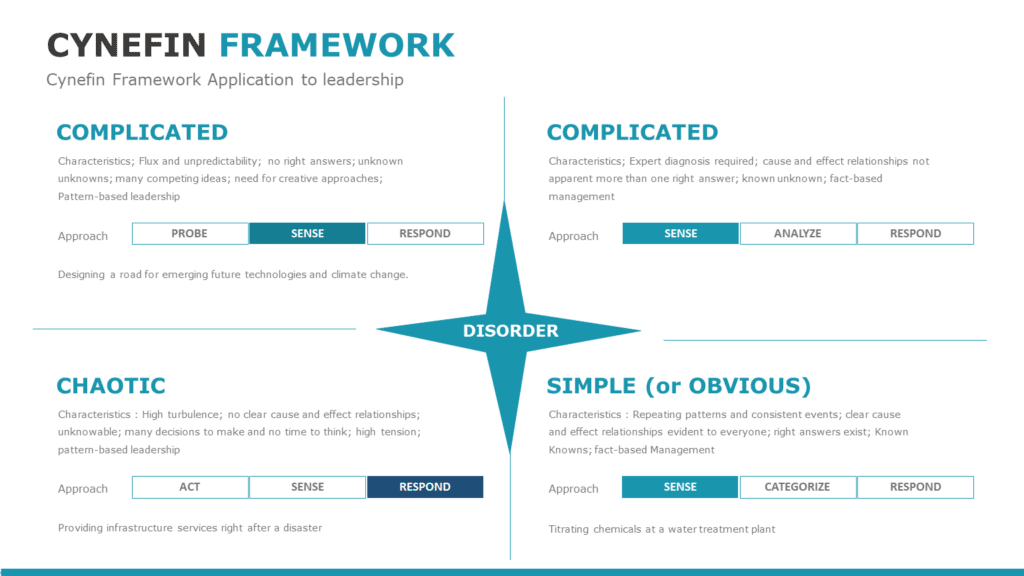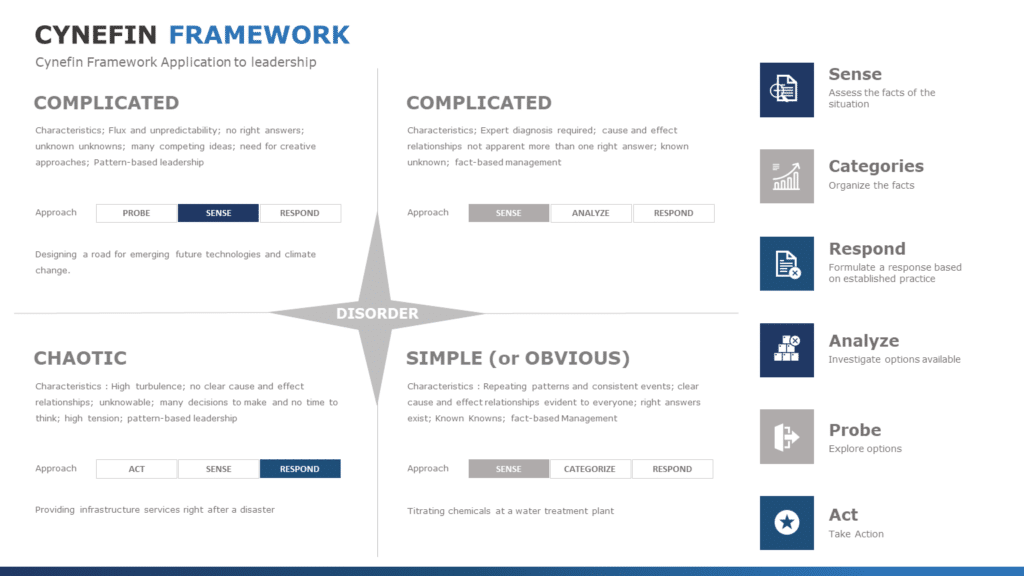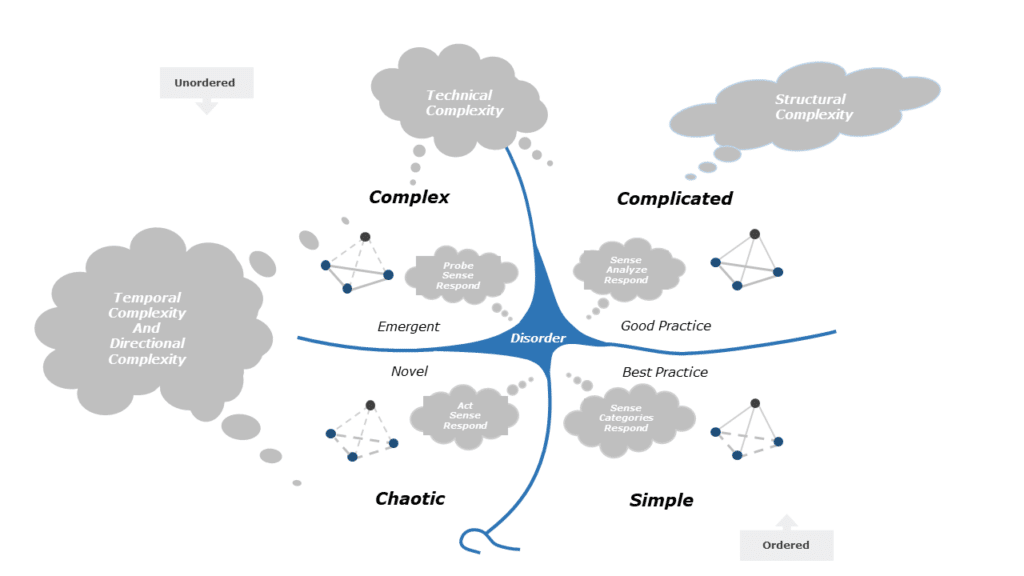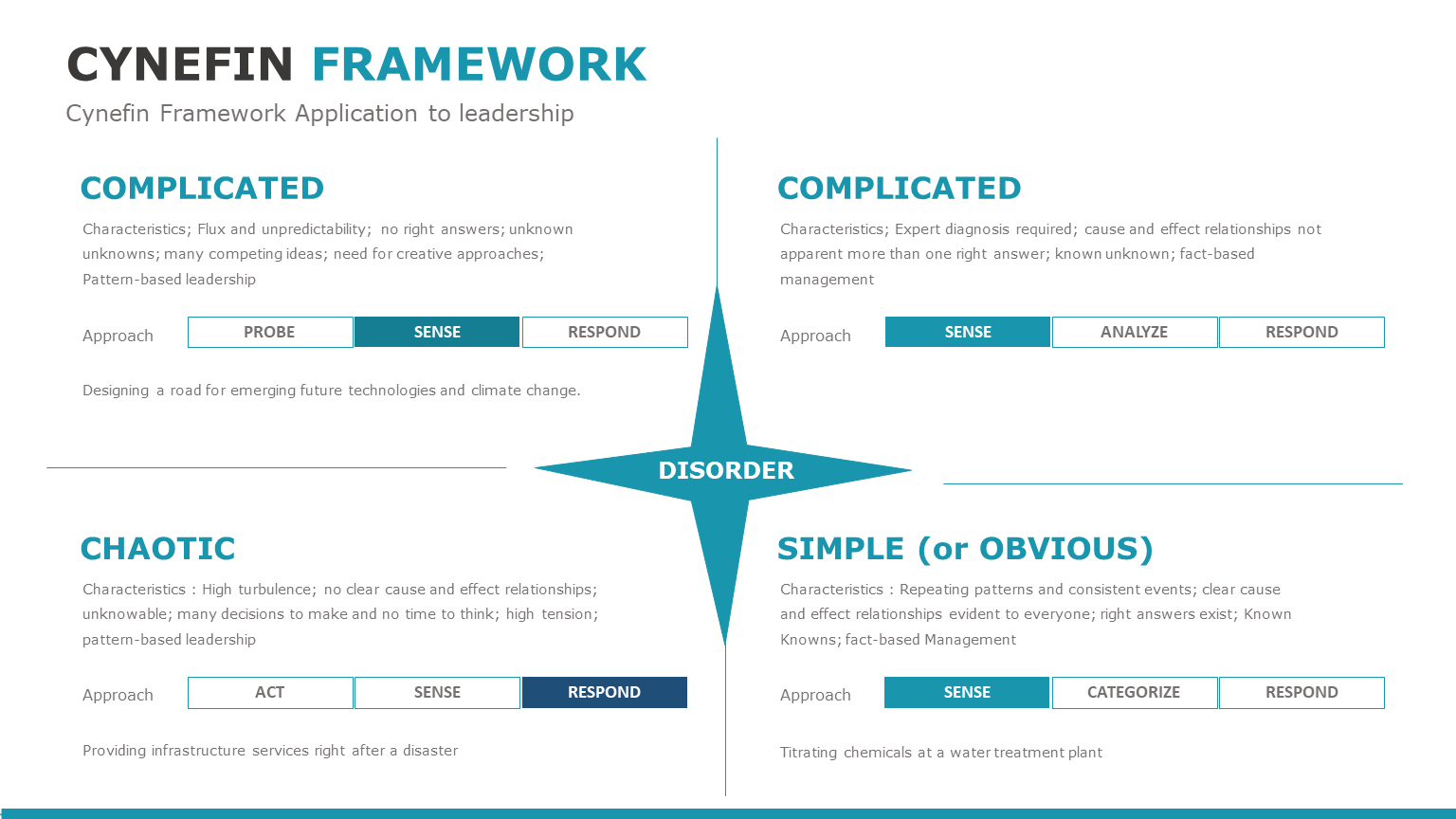The most effective managers recognize that problem solving is not a one-size-fits-all process. They know that their actions will be based on situations and they have to make informed decisions by making their approach adaptable to different circumstances.
But how do you know which approach to carry in a given situation? And how do you avoid making a bad decision?
In this article, we’ll look at the Cynefin framework, a tool that can help you make better decisions by assessing your current situation.
So what are you waiting for?
Let’s get started!
What is the Cynefin Framework?
The Cynefin framework encourages you to think through a situation and determine the best course of action. It contains five domains: obvious, complicated, complex, chaotic, and disorder.
The Obvious domain includes situations that you’ve encountered before and for which you have best practices.
The Complicated domain applies to situations in which you don’t know what’s going on but have the skills to analyze the situation and determine what needs to be done.
When it comes to the Complex domain, it is quite challenging to find a single correct solution to deal with the respective situation.
In the Chaotic domain, the environment is unstable, so you must act quickly.
The Disorder domain encompasses any situation in which you are unable to determine the nature of your surroundings. In each domain, the framework provides a model for a manager’s behavior.
In a variety of situations, you can apply the Cynefin framework to categorize a problem or decision and respond accordingly. It is useful in areas such as product development, marketing, and organizational strategy. It can also assist you in making better decisions during a crisis or emergency.
It encourages you to be flexible and adaptable when making decisions and to adjust your management style to fit your circumstances, which helps you avoid using the same management style or decision-making approach in all situations – a costly mistake for your team or organization.
How Is The Cynefin Framework Set Up?
There are five domains in the Cynefin Framework: obvious, complicated, complex, chaotic, and disorder. Obvious problems are well understood, and their solutions are evident, so they can be solved by applying a well-known, potentially scripted solution. In the case of complicated problems, you somewhat have a sense of your question and its respective solution.
You can use expert knowledge to solve these types of problems and decide what to do next. There’s a lot you don’t know when it comes to complex problems—you’re not even sure which questions to ask.
To solve complex problems, you must experiment, evaluate, and learn more. When dealing with chaotic problems, your first priority should be to contain them before attempting to find a long-term solution.
The space in the middle of the framework is referred to as disorder. If you’re not sure where you are in the framework, you’re in Disorder, and your priority should be to move to one of the other domains.
When Should You Use The Cynefin Framework?
The Cynefin framework is a powerful and adaptable behavioral model. You can use the framework whenever you need to categorize a problem or decision and determine the best course of action. The framework is used by many organizations to help with product development, marketing plans, and organizational strategy.
It can also be used to respond to a crisis or other unforeseen event. Use this framework to train new employees on how to respond to such an event or to practice worst-case scenarios.
The Five Domains Of The Cynefin Framework
The Cynefin framework consists of five domains that differ primarily in terms of their cause-and-effect relationship:
Simple
The cause-and-effect relationships are clear in simple situations, and the problem-solving approach is simple to identify and pursue. As a result, the suggested course of action is a sense – categorize – response. Best practices from similar situations can be used in this situation.
Complicated
A clear cause-and-effect relationship exists in complicated situations as well. However, expert knowledge is required to make decisions because non-linear processes and multiple variables are at work here. The more complicated the system, the more critical it is for project participants to communicate with one another and conduct an in-depth analysis of the situation. The sequence of events should be as follows: sense – analyze – respond.
Complex
The situation is complex when there are too many factors to identify the cause-and-effect connection and come up with a credible solution. Complex situations are usually agile, and their particular factors fluctuate; consequently, agile management strategies should be employed here. Trial and error, inventiveness, diversity, and ongoing communication (probe – sense – reply) can be used to solve a complex situation.
Chaotic
In chaotic systems, there is no clear causal connection. Old structures and processes no longer work, and new ones have yet to be formed. To transfer the chaotic situation into a different domain, quick action and a strong leader are required. The resulting basic, complicated, or complex situation can then be correctly reacted to (act – sense – reply). A chaotic situation is comparable to a stock market crash — an ambiguous situation that appears hard to bring order to.
Disorder
What is the current state of affairs? Suppose you are unsure about the type of cause-and-effect connection you are dealing with. In that case, you mustn’t fall back into your comfort zone and adopt handy solutions simply because they are known to you. Embracing ambiguity and attentively studying patterns of action and behavior might help you seek new avenues and learn lessons for future uncertain situations.
How Leaders Can Use This Framework?
Cynefin fundamentally refers to the various factors in our surroundings and experiences that impact us in inexplicable ways. Using this approach, leaders learn to demonstrate their framework based on the history and context of their own organization. This improves communication and allows Corporate leaders to grasp the environment in which they operate quickly.
The Cynefin framework was created to assist leaders in understanding their challenges and making decisions in context. It understands that our actions must reflect the reality we find ourselves in through a sense-making process by identifying distinct domains (the subsystems in which we work).
This enables leaders to acquire an understanding of what is truly complicated and what is not and to respond accordingly so that no energy is lost overthinking the mundane, but they also never attempt to squeeze the complex into standard solutions.
Common Mistakes When Applying The Cynefin Framework
The Cynefin framework is a practical decision-making approach that concentrates on finding the solutions on the spot instead of the project’s long-term success. If you do not keep this in mind, challenges with project management may occur, or the project may fail totally.
Using a simple technique in a complex or complicated situation
Simple circumstances are easier to manage. As a result, many managers prefer to distort and simplify the scenario at present. As a result, disastrous decisions may be taken, threatening the project’s success.
Managing a complex situation utilizing the techniques for a complicated situation
Expert knowledge and extensive analysis are used to manage a complicated system. However, if you adopt this approach in a complex system, you risk becoming bogged down in analytical loops and ineffective processes.
Failure to perceive a chaotic situation:
If the system becomes chaotic, a quick response and the appropriate management strategy are required to bring the chaotic situation under control as soon as feasible. If you behave too tentatively as a manager or impose less than optimal regulations for the organization, it might have long-term consequences.
Best Cynefin Framework Template
The Cynefin Framework is an excellent model for laying out how we can approach these various situations and explaining the characteristics that will help us recognize the current situation. The appropriate problem-solving approaches can then be used once the situation has been defined.
If you believe it will be difficult to convey the Cynefin Framework concept to your audience, you have come to the correct spot. You can make your task much simpler by using these customizable and resourceful Cynefin framework templates. This will save you time and ensure that your audience retains the information you share on the subject. It’d be a win-win situation for both you and your audience!

Cynefin Framework
Source: Cynefin Framework by SlideUpLift

Cynefin Framework
Source: Cynefin Framework by SlideUpLift

Cynefin Framework
Source: Cynefin Framework by SlideUpLift
Wrapping It Up
In a nutshell, the Cynefin framework not only instructs us on how to handle a variety of circumstances, but the characteristics also explain enough to assist us in recognizing the situation in which we presently dwell. You can have wonderful solutions, but if you use them in the wrong context, they will be useless or, worse, detrimental.
This framework is beneficial not just for pointy-haired management people but also for software engineers and all other individuals! This can be applied to a wide range of life experiences. The bottom line is that you must match the proper approach to the right situation in order to obtain the best results!
Now you don’t have to scour the web to find out the right templates. Download our PowerPoint Templates from within PowerPoint. See how?
Looking For Powerpoint Design Agency?
Call Pursho @ 0731-6725516
Telegram Group One Must Follow :
For Startups: https://t.me/daily_business_reads
#Cynefin #Framework #Tool #Situational #Leadership






